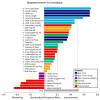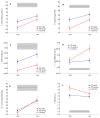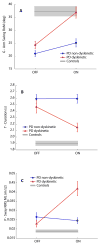Levodopa Is a Double-Edged Sword for Balance and Gait in People With Parkinson's Disease
- PMID: 26095928
- PMCID: PMC4755510
- DOI: 10.1002/mds.26269
Levodopa Is a Double-Edged Sword for Balance and Gait in People With Parkinson's Disease
Abstract
Background: The effects of levodopa on balance and gait function in people with Parkinson's disease (PD) is controversial. This study compared the relative responsiveness to l-dopa on six domains of balance and gait: postural sway in stance; gait pace; dynamic stability; gait initiation; arm swing; and turning in people with mild and severe PD, with and without dyskinesia.
Methods: We studied 104 subjects with idiopathic PD (H & Y II [n = 52] and III-IV [n = 52]) and 64 age-matched controls. Subjects performed a mobility task in the practical off state and on l-dopa: standing quietly for 30 seconds, initiating gait, walking 7 meters, and turning 180 degrees. Thirty-four measures of mobility were computed from inertial sensors. Standardized response means were used to determine relative responsiveness to l-dopa.
Results: The largest improvements with l-dopa were found for arm swing and pace-related gait measures. Gait dynamic stability was unaffected by PD and not responsive to l-dopa. l-dopa reduced turning duration, but only in subjects with severe PD. In contrast to gait, postural sway in quiet standing increased with l-dopa, especially in the more severely affected subjects. The increase in postural sway, as well as decrease in turning duration and exaggerated arm swing with l-dopa was observed only for subjects with dyskinesia at the time of testing.
Conclusions: The observed spectrum of l-dopa responsiveness in balance and gait measures suggests that multiple neural circuits control balance and gait. Many of the negative effects of l-dopa may be directly or indirectly caused by dyskinesia.
Keywords: Parkinson's disease; balance; gait; inertial sensors; levodopa.
© 2015 International Parkinson and Movement Disorder Society.
Conflict of interest statement
OHSU and Dr. Horak have a significant financial interest in APDM, a company that may have a commercial interest in the results of this research and technology. This potential institutional and individual conflict has been reviewed and managed by OHSU.
References
-
- Rochester L, Baker K, Nieuwboer A, Burn D. Targeting dopa-sensitive and dopa-resistant gait dysfunction in Parkinson’s disease: selective responses to internal and external cues. Movement disorders : official journal of the Movement Disorder Society. 2011 Feb 15;26(3):430–5. - PubMed
-
- Beuter A, Hernandez R, Rigal R, Modolo J, Blanchet P. Postural sway and effect of levodopa in early Parkinson’s disease. The Canadian journal of neurological sciences Le journal canadien des sciences neurologiques. 2008;35:65–8. - PubMed
-
- Delval A, Tard C, Defebvre L. Why we should study gait initiation in Parkinson’s disease. Neurophysiologie clinique = Clinical neurophysiology. 2014 Jan;44(1):69–76. Epub 2014/02/08. eng. - PubMed
Publication types
MeSH terms
Substances
Grants and funding
LinkOut - more resources
Full Text Sources
Other Literature Sources
Medical





